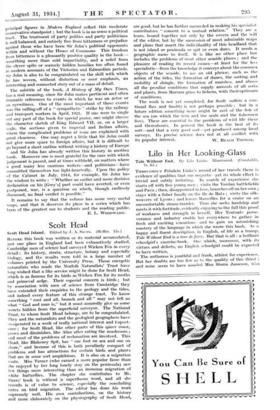Scolt Head
Scolt Head Island. Edited by J. A. Steers. (Helfer. 153.) BEFORE this book was written or its material accumulated, just one place in England had been exhaustively studied. Cambridge men of science had surveyed Wicken Fen in every detail : its history, strata, structure, botany and especially biology, and the results were told in a large number of volumes printed by the University Press. Those energetic naturalists who made the Norfolk Naturalists' Trust have long wished that a like service might be done for Scolt Head, which is as famous for its birds as Wicken Fen for its moths and primeval sedge. Their especial concern is birds ; but by association with men of science from Cambridge they have extended their enquiries to the geology and the tides, and indeed every feature of this strange tract. To know something " root and all, branch and all " may not tell us what " God and man is," but it must -assuredly give us some secrets hidden from the superficial surveyor. The National Trust, to whom Scolt Head belongs, are to be congratulated. They and the naturalists and the geological geographers have eo-operated to a work of really national interest and import- ance ; for Scolt Head, like other parts of this queer coast, grows and diminishes, like Alice after eating the mushroom ; and most of the problems of reclamation are involved. This Head, like Blakeney Spit, has " one foot on sea and one on shore," and because of this is both peculiarly compact of problems and has attractions for certain birds and plants that are in some sort amphibious. It is also on a migration route. Miss Turner (who earned a more popular fame than she enjoyed by her long lonely stay on the peninsula) saw few things more interesting than an immense migration of white butterflies. The chapter she contributes to Mr. Steers' book is without a superfluous word, and all she records is of value to science, especially the concluding notes on bird migration. The editor has done his work supremely well. His own contributions, on the history and more elaborately on the physiography of Scolt Head, are good, but he has further succeeded in making his specialist contributors " consent to a mutual relation." They are a team, bound together not only by the covers and the will of the editor, but by the succession of most admirable maps and plans that assert the individuality of this headland that is not island or peninsula or spit or even dune. It needs a geographic name to itself. It is like no other place but includes the problems of most other seaside places ; and the pleasure of reading its record comes—at least for the less specialistic—from the knowledge it conveys about the common objects of the seaside, to use an old phrase, such as the action of the tides, the formation of dunes, the sorting and mobility of shingle, the formation of marshes, and above all the peculiar conditions that supply animals of all sorts and plants, from Marram grass to lichens, with their optimum of conditions.
The work is not yet completed, for Scolt suffers a con- tinual flux and finality is not perhaps possible ; but in a future edition something more might be said of the fish of the sea (on which the tern and the seals and the fishermen live). These are essential to the problems of wild life there and thereabouts. In general the book is the best of itv sort—and that a very good sort—yet produced among local surveys. Its precise science does not at all conflict with






































 Previous page
Previous page